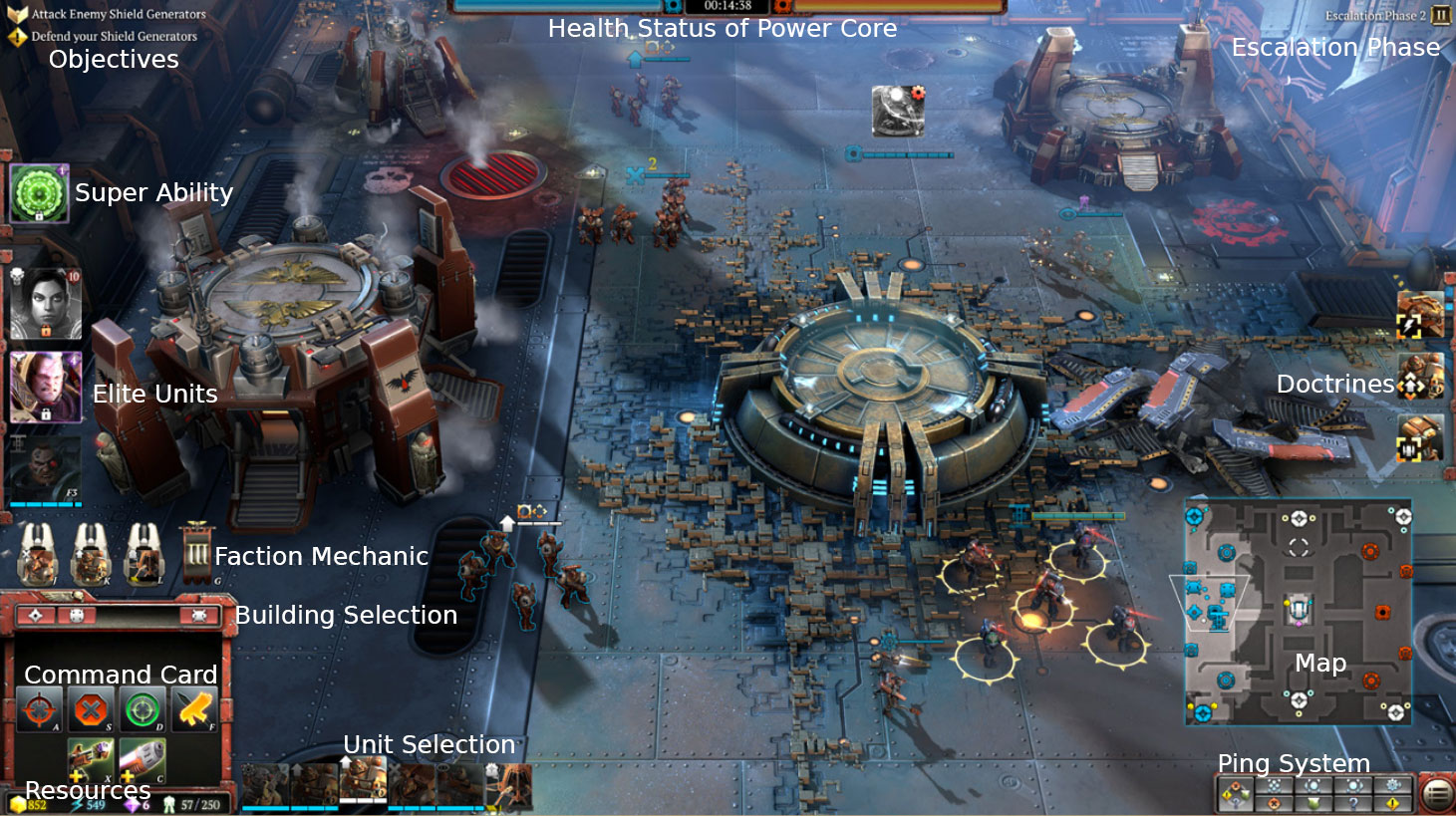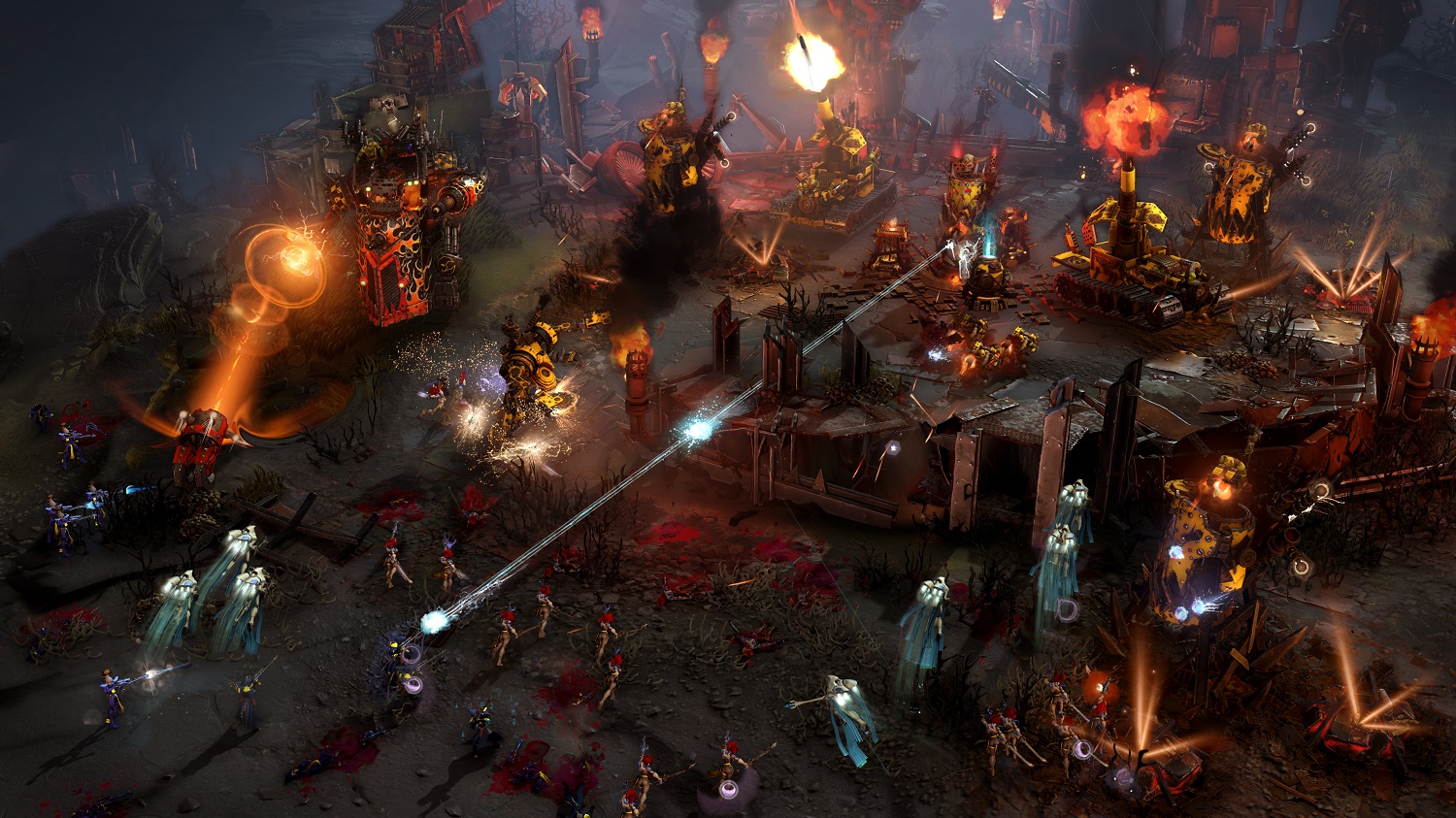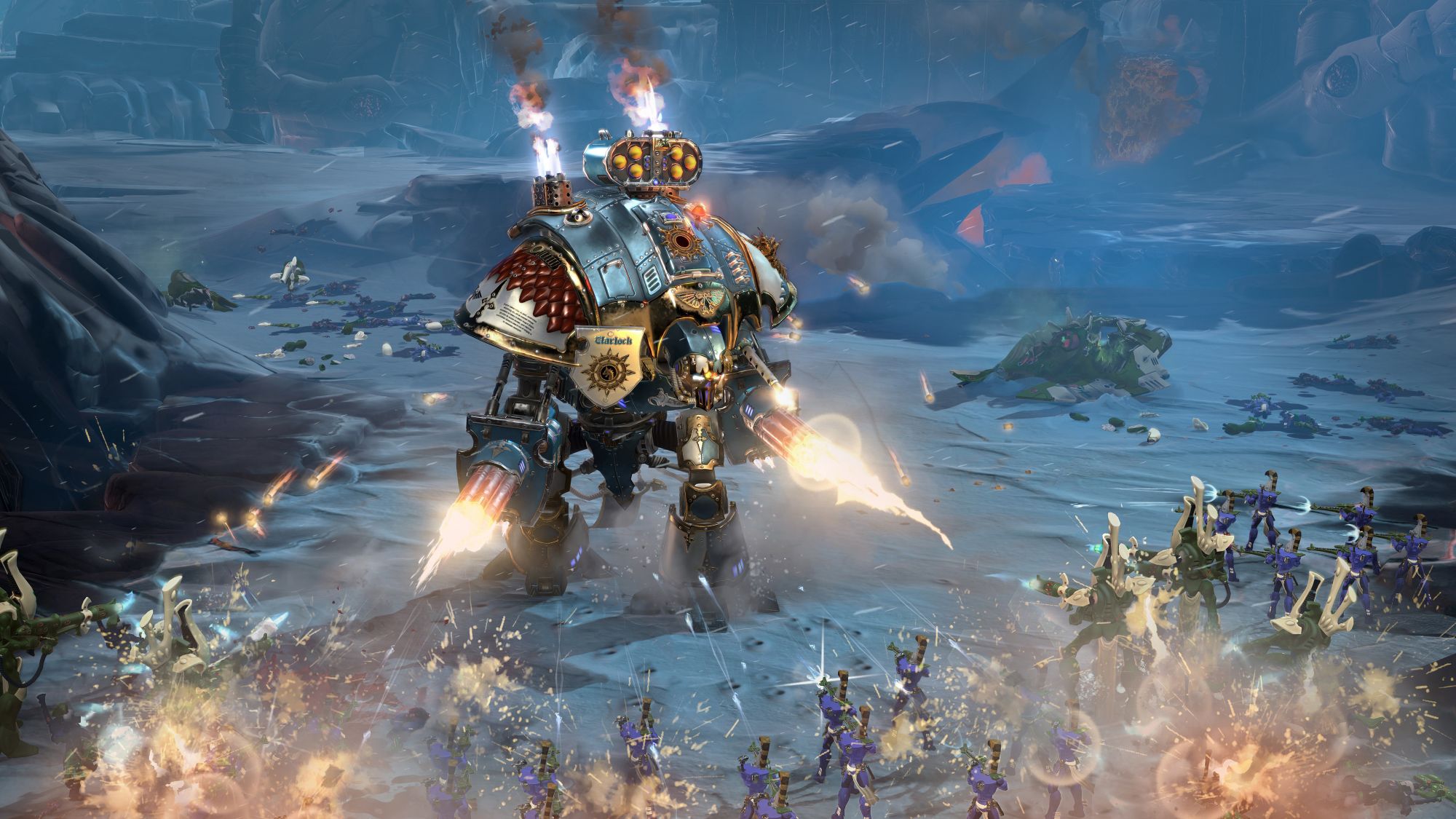Search
[{{{type}}}] {{{reason}}}
{{/data.error.root_cause}}{{{_source.title}}} {{#_source.showPrice}} {{{_source.displayPrice}}} {{/_source.showPrice}}
{{#_source.showLink}} {{/_source.showLink}} {{#_source.showDate}}{{{_source.displayDate}}}
{{/_source.showDate}}{{{_source.description}}}
{{#_source.additionalInfo}}{{#_source.additionalFields}} {{#title}} {{{label}}}: {{{title}}} {{/title}} {{/_source.additionalFields}}
{{/_source.additionalInfo}}Dawn of War III (PC)

Dawn of War III
Released: Month day, year
Published by: Sega
Developed by: Relic Entertainment
ESRB Rating: M
Available on: Windows PC, Linux, macOS
Release Date: April 27, 2017
Genre: RTS
Number of Players: 1+
Price: $23.21
(Kinguin.net Affiliate Link)
Thank you Kinguin.net for sending us this game to review!
Following the amazing trailer and two amazing games that came before it, Dawn of War III had a lot to live up to.
I really enjoyed the previous Dawn of War titles and have eagerly been looking forward to this one. I have enjoyed the story so much I actually went ahead and read the novelization of the Dawn of War story by C.S. Goto and yes... I liked it. I added a detachment of Blood Ravens to my Black Templars army in Warhammer 40,000 and got up to my neck in the lore. (The Blood Ravens are totally, secretly a loyalist successor chapter to the Thousand Sons, amirite, 40k fans?)
So about this game...
For you 40k fans: This game is not designed with 8th Edition in mind. Eldar are Eldar and there are no Primaris Marines (so far, at least).
The campaign story picks up after the events of Dawn of War II (good guy ending), but does so with a slight retcon. Gabriel Angelos is the Chapter Master of the Blood Ravens but appears to look a lot better than he did at the end of the previous story. This tale begins with an Imperial settlement under assault by a massive force of Space Orks, and Chapter Master Angelos orders the Blood Ravens to land on the planet to help with the defense. The problem is that the Imperial Inquisition had told the marines to stand down, but Angelos doesn't take orders from Inquisitors...
What I found a bit jarring is that a few missions into the campaign, the player switches from controlling the Blood Ravens to playing as the Orks. The reason I found it weird is that it felt strange to be working in the defense of the Imperial settlement at one point, then switching to the Orks whose goal it is to come in and cause as much mayhem and destruction as they can. It's true that a lot of games involve a campaign in which the player switches from one faction to another as the story progresses, but usually it doesn't involve having to work against one's own goals in the story. To its credit, Dawn of War III seems to be trying to get the player familiar with, and maybe even a little invested in, the villains (or foils, if you prefer) in the story to have a greater narrative payoff at the end. your mileage may vary here, so I don't mean to be overly critical on that point. Of course, after the Ork missions come some Eldar missions. Completing missions advances the storyline and it is possible to set the difficulty of each mission independently, so if there's a particular mission that feels too difficult or too easy, it can be played at a different setting. Also, warlords gain experience as they progress through the campaign which can be spent on upgrades.
There's a tutorial available that helps the player get used to the new features available in Dawn of War III. That's a good thing, because it's now possible to construct different buildings which unlock access to a greater variety of units and upgrades. For the Eldar, Webways can be built from buildings to allow units to teleport across the map. To be honest, it's really starting to feel like StarCraft, in that there's even a worker unit that is assigned to building construction, which is a semi-new feature for the franchise. It's nice to have more options than before, but at the same time it feels less original. This is what I mean by feeling derivative. There have been lots of Real Time Strategy games that work on the same basic formula of having worker units to build buildings, using those buildings to construct units, and having some kind of mechanism for harvesting and managing resources. While some of these elements have been present in Dawn of War titles before, the worker units really tip the balance. Dawn of War now feels less like Warhammer 40,000 to me and more like StarCraft in this edition.

Strong Points: Delivers an experience that's consistent the Dawn of War series
Weak Points: Feels derivative and not very original
Moral Warnings: Lots of violence and some occult themes
If you've ever been playing a previous version of Dawn of War and thought to yourself "Gee, I really love using the special abilities of the Commander, but sometimes it's kinda hard to see him in that huge group of marines and Orks" then maybe the game developers heard you. Angelos is huge compared to the other Blood Ravens, and I mean Primarch proportions. (If you don't know what that means, I'm saying Angelos is nearly twice as tall as the marines around him.) This makes him easy to find on the screen, but breaks the immersion a bit for me. Of course it makes perfect sense that the Ork Warboss is huge compared to his followers, and I do admit this makes it easier to find your most important unit. On the Eldar side, Macha is also much larger than the other troops.
In terms of the toughness of characters, gone are the days when a named character was knocked down and you could revive him by bringing along another character to aid him. Now, characters are tougher to kill, but when they go down, the mission ends in failure. Needless to say that means gameplay is decidedly more conservative now than it was in previous Dawn of War iterations. A large health bar appears above the head of the character to make it easy to see, which is very, very useful with how quickly such a character can get mobbed by enemy units.
Mission length hasn't changed much, with each mission taking around thirty to sixty minutes to complete depending on how thoroughly the player searches the map or what tactics they use. Thankfully, there is a manual save feature that can be used at any time in case the player is interrupted and has to complete the mission later, or wants to simply create a save point. (Immensely useful now that the mission fails if the commander dies.)
It's nice to have access to Knight Titans now in Dawn of War as well, but I honestly didn't find it to be much of a game changer. It's like using TItans in Tabletop Warhammer 40,000. Huge, impressive, terrifying, but still it's the same game. In a way, that's a good thing, because it does help make the game feel true to its 40K roots.
I did find it annoying at one point where I placed an Ork "Da Boyz Hut" down in a space where I thought there would be room for units to move around it. I was wrong, and every other unit it generated was trapped behind it and couldn't move. As far as I could tell, there is no mechanism for destroying your own buildings so I was stuck with it there and the units behind it never got to do anything.
The upgrade system for unit equipment is changed, now being handled at the new buildings. Marines can also return to these structures for reinforcements when they take losses from their unit. Orks upgrade their units by gathering scrap and again I see a move toward more "standard" RTS (Real Time Strategy) games in that there's resource gathering. Dawn of War has always had a mechanic for resource gathering through structures built on control points that generate materials needed to build new units, and that system does still exist here. It's just that upgrades to units (like adding armor to Ork Boyz) requires the extra detail.

Higher is better
(10/10 is perfect)
Game Score - 80%
Gameplay - 17/20
Graphics - 8/10
Sound - 7/10
Stability - 4/5
Controls - 4/5
Morality Score - 72%
Violence - 4/10
Language - 9/10
Sexual Content - 10/10
Occult/Supernatural - 7/10
Cultural/Moral/Ethical - 6/10
The game control setup is the same as previous Dawn of War titles, using the keyboard and mouse. As before, units can be selected by clicking on one of their members or by drawing a box around them.
The game has an Army Painter feature, which isn't unusual for a 40K title where you can experiment with different color schemes for your army. This lets a player who also owns a tabletop army to try out different ideas before putting the brush to the models. Of course, this also determines what your army will look like when playing in Multiplayer. Default options for established chapters like Black Templars, Ultramarines or Blood Angels are there, with the ability to create custom chapters. The downside is that the chapter badges on the marines' left shoulder has to be chosen from existing logos, which makes it hard to feel like the custom chapter is truly your own. Also, (and this is incredibly minor, I admit) all of the chapter iconography on the right shoulder is selected from codex chapters, like the up arrow icon for Tactical Squads, crossed arrows for Assault Squads, etc. Some chapters don't use this pattern in the 40k fluff. Multiplayer games can be played in 1v1, 2v2 or 3v3 formats, and the player can even select the difficulty of the opponent to be played against. The player can choose which faction (Space Marines, Orks or Eldar) and which sub-faction (which affects the look of the army). It works basically the same as playing the A.I. in that the player controls key strategic points on the map and builds useful structures on them in order to ultimately destroy the opponent(s).
The graphics are not much different from previous Dawn of War titles, but I'm okay with that, as they've always been good anyway. My machine did have a low framerate but I blame my machine, not the game. (I am running an HP EliteBook laptop with 8GB RAM and a 2.70 GHz Intel i7. Graphics card is an AMD Radeon HD 6470M.)
This is nitpicky, I admit... but the Cockney accent used with Orks gets incredibly annoying when you're hearing the same phrases over and over as you give commands to your units. It's funny for about the first five minutes but after that I was ready to mute the game. I know that's purely thematic and just my own personal opinion, but man... The sound effects are fine, which is to say they were competently done and held to the standards set by 40K games in general. I didn't have any issues with the sound quality, though at one point during a loading screen a bizarre, high-pitched buzz came blasting out of my speakers until the mission started, but it only happened once and was fine after.
The game plays smoothly and didn't crash or freeze when I was playing. I did notice a couple of minor issues. At one point the health bar for a particular Ork was about three inches to the left of where he actually was. I had to occasionally order the Ork Warboss to throw his claw a couple of times before it worked. Lastly, at one point I was unable to get a depleted unit of Ork Boyz to realize that it was close enough to a Boyz Hut to enable the reinforcements button.

I know I say this with every 40k game I review, but it's still true and needs mentioning. This is a game set in the grimdark universe of Warhammer 40,000, which means it's violent, bloody and brutal. When troops are slain they lay in a splatter of blood until they gradually fade out, and the level of destruction in the setting is reminiscent of the climax of Man of Steel or The Avengers. All in all, fairly on par for a 40k title.
On the upside, the 40k setting has never been one for any kind of nudity or significant sexual content, and I didn't see any in this game either. (I haven't finished the campaign yet but I'd be shocked right to my toenails if there is any later on.)
Again, as is common in the 40k universe, there are occult themes in the form of human Psykers (people who can use psychic abilities) and the Chaos Gods. Also, the Space Marines revere the Emperor of Mankind almost at a godlike level. (In older game fluff they did see him as a god, now only the Black Templars do.)
I was glad that when playing the Orks, there was no call for the player to kill civilians or engage in any over-the-top brutality. Yes, you do fight and kill soldiers, but that's all. All of the violence is within the context of battle, not just wanton slaughter. Even so, the Orks are a violent, hostile alien race that lives only for battle, and you control them as they attempt to destroy humans and other aliens. Thought provoking question though; gameplay isn't really different between Orks, Eldar and Space Marines. What does that say about those factions?
I really enjoyed this game, but it isn't much of a change over previous Dawn of War games. It gave me exactly what I expected in that the game developers competently created a game that plays much like its predecessors, but they didn't take many risks here. I recommend it to anyone who liked the Dawn of War series or who is into Warhammer 40,000 in general. This game isn't for the little kids or those who are uncomfortable with violence.








